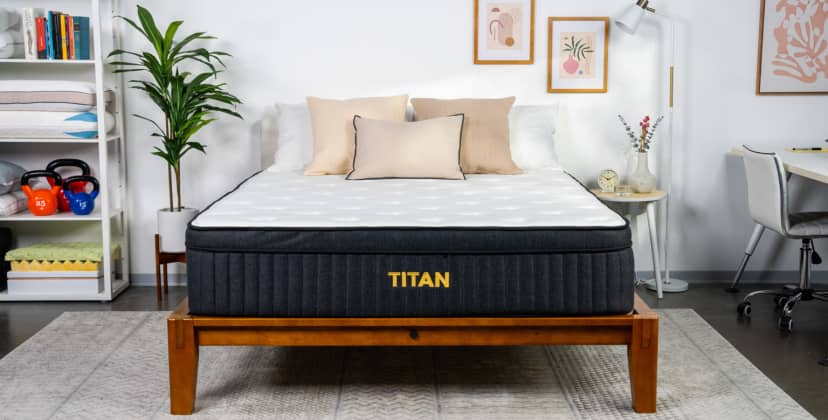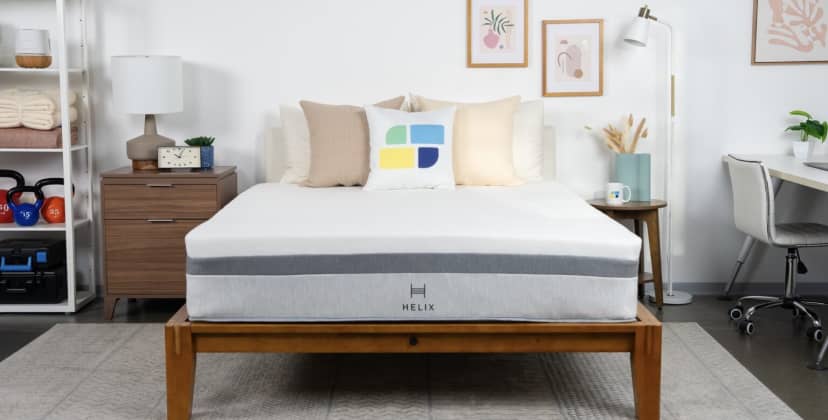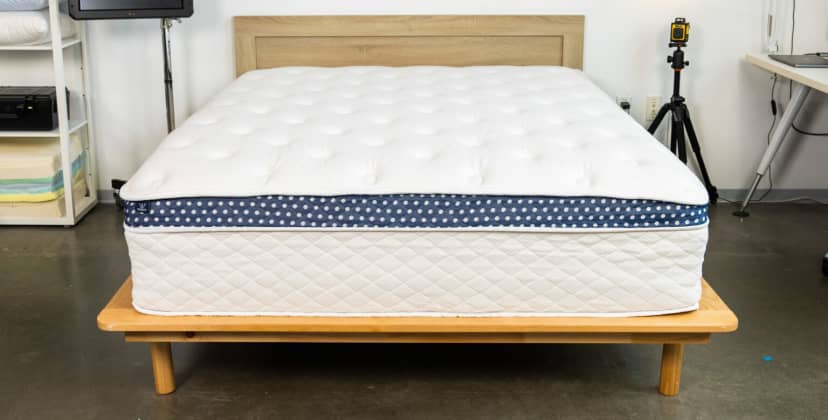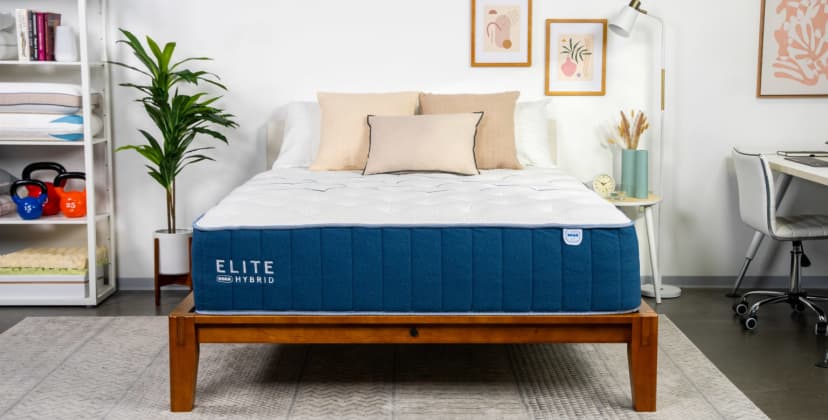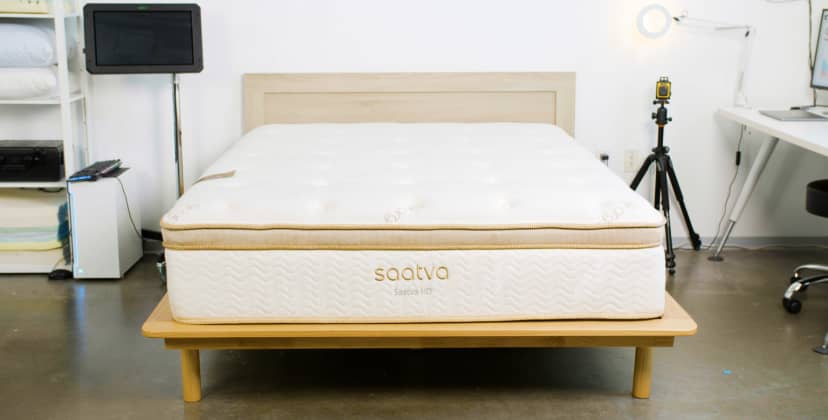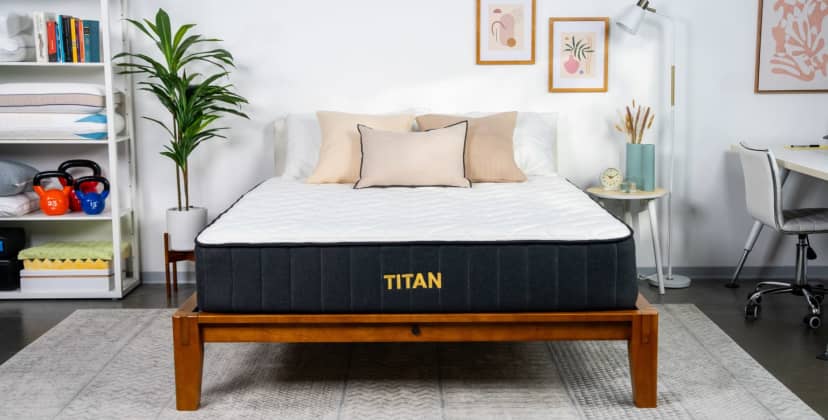When you buy through our links, we may earn a commission. Products or services may be offered by an affiliated entity. Learn more.
Best Mattress for Heavy People
If you weigh 230 pounds or more, you’ve probably noticed that not every mattress is built with your sleep needs in mind. That’s why I put together this guide. My weight falls slightly below 230 pounds, but I share many of the same considerations when it comes to finding the right mattress, including the need for solid support, a surface that’s easy to move on, and materials that won’t hug me too closely and trap body heat.
I’ve also spent the past several years testing mattresses with a team of people representing a wide range of body types and sleep styles, and one thing I’ve learned is that finding the right bed is less about labels like “average weight” or “plus-size” and more about understanding how your body interacts with different materials, firmness levels, and support systems.
Below, I’ll share what I’ve learned about which mattresses tend to work best for heavier people, based on both data from our Test Lab and real-world feedback.
Our Top Picks
- Best Mattress Overall – Titan Plus Luxe
- Most Comfortable Mattress – Helix Plus
- Best Value Mattress – DreamCloud Classic Hybrid
- Best Mattress for Back Pain – WinkBed Plus
- Best Mattress for Couples – Leesa Plus Hybrid Mattress
- Best for Side Sleepers – Nolah Evolution Comfort+
- Best Mattress for Hot Sleepers – Brooklyn Bedding Aurora Luxe
- Best Mattress for Hip Pain – Bear Elite Hybrid
- Best Luxury Mattress – Saatva HD
- Best Extra-Firm Mattress – Titan Plus
Our Approach to Weight and Mattress Needs
Before we get started, I want to clarify how we talk about body weight. For the purposes of this page, I’m talking about mattresses for people who weigh 230 pounds or more. Why 230 pounds? Most mattresses are designed for people up to 250 pounds, but heavier people sink deeper into a mattress and thus need extra support to maintain healthy spinal alignment.
But I’m under no illusions that this number is perfectly representative. I use the term “heavy” for brevity and convenience, not because there’s a universal definition or cut-off. And ultimately, I find terms like “average weight” or “overweight” more subjective and potentially misleading (over what weight?).
What’s important isn’t a number on a scale; it’s helping people get the best sleep they can. And I hope this guide proves useful to people who might otherwise find it challenging to find a high-quality mattress that suits their needs.
- Strong Support System: Look for sturdy coils or high-density foam layers that keep your spine aligned and help the mattress hold its shape over time.
- Quality, Durable Materials: A well-built mattress holds up to everyday use and won’t wear out before its time, even under more weight.
- Midsection Support: Extra support through the middle of the mattress helps keep your lower back and hips from dipping out of alignment.
- Robust Edge Support: Solid edge support makes it easier to sit or sleep near the sides without feeling like you might slide off.
In-Depth Reviews
Our testing team members over 230 pounds were pretty nearly unanimous: The Titan Plus Luxe is a great mattress for heavy people — it contours comfortably without sacrificing the sturdy support you really need. You can also choose between the standard cover or upgrade to a cooling cover if you tend to sleep hot.
-
Pros
-
Medium firm hybrid design provides balanced contouring and support
-
Gentle contouring minimizes impact around joints and pressure points
-
Robust materials limit sinkage and improve durability
-
-
Cons
-
Coils can generate movement and disrupt sleep for couples
-
May not provide enough cushioning for some side sleepers
-
Mattress Type
Hybrid
Firmness Options
Medium Firm (6)
Price Range
$629 – $1,364
Trial Period
120 nights (30-night requirement, $99 return fee)
The Titan Plus Luxe from Brooklyn Bedding strikes a nice balance between surface-level contouring and overall stability. Multiple foam layers cushion your body, evenly distribute your weight, and reduce pressure along the spine, but we noticed excellent support and minimal sinkage during our hands-on mattress tests.
How It Performed
Our side sleepers weighing more than 230 pounds awarded the Plus Luxe excellent ratings. The medium firm (6) feel and deep foam layers provided ample cushioning for the hips and shoulders but none of us reported excessive sinkage. Our back sleepers in this weight range also felt adequately supported.
We found cooling to be one of the Plus Luxe’s biggest strengths. Thanks to the breathable foam layers and steady airflow through the coil layer, we noticed little heat buildup when our team tested the mattress for temperature control.
That said, people who sleep exceptionally hot should consider the cooling cover upgrade. The coils were also sturdy and responsive enough to earn the Plus Luxe high marks during our edge support and ease of movement tests.
Construction Breakdown
The Plus Luxe features a Euro-top cushioned with memory foam quilted into the cover for a bit of plushness on the surface. The comfort layer of proprietary TitanFlex foam is designed to mimic the responsiveness of latex, so you’ll notice a gentle bounce when getting into bed. A polyfoam transitional layer serves as a buffer between your body and the support core while providing additional cushioning.
Pocketed coils over high-density base foam provide excellent overall stability for the mattress, reinforcing the springy feel without generating too much motion transfer. A polyester cover encases the mattress. For an added fee, you can upgrade to a cover made of GlacioTex infused with phase change material. This fabric dissipates heat on contact to help maintain a cool sleep surface at all times.
The Helix Plus is built with extra support in mind for sleepers over 230 pounds, and in my experience, it strikes a nice balance between sturdy and comfortable. The Dynamic Response Foam adds just enough cushioning and bounce, while the dense foam and thick coils give it the kind of durability you want in a mattress built to last.
-
Pros
-
Robust design that supports up to 1,000 pounds
-
Reliable edge support
-
Provides a flat and supportive sleep surface that’s great for back and stomach sleepers
-
-
Cons
-
Not an ideal fit for sleepers who want deep contouring
-
Movement on one side of the mattress causes vibrations on the other side
-
Mattress Type
Hybrid
Firmness Options
Firm (7)
Price Range
$649 – $1,449
Trial Period
100 nights (30-night requirement)
Designed with heavier sleepers in mind, the Helix Plus is one of Helix Sleep’s firmest and most supportive mattresses. This firm (7) luxury hybrid delivers a comfortable experience to its intended audience with dense foam over thick coils. This is a tried-and-true combination for people over 230 pounds who tend to sink excessively on softer mattresses with less robust support systems.
How It Performed
The Helix Plus was a hit among our testers weighing more than 230 pounds and received stellar ratings from all three sleep position groups. Due to the thick foam layers, we found the Helix Plus performed well in areas where hybrid models tend to fall short. Our testers noticed minimal transfer when lying side by side to test for edge support, and we detected little pressure buildup in most of our testers during the pressure relief tests.
At the same time, the mattress felt responsive enough for us to move across the surface without feeling stuck, and our edge support tests revealed solid pushback along the perimeter.
Construction Breakdown
The Helix Plus’ comfort system consists of three foam layers. High-density memory foam cushions the surface, contouring to your body closely and evenly to distribute your weight, followed by polyfoam and memory foam layers that provide additional cushioning while keeping you on an even plane.
The support core contains pocketed coils, extra perimeter reinforcement and a high-density foam base layer. The cover is composed of breathable Tencel fabric. You can order a GlacioTex phase change cover for an additional fee that dissipates body heat on contact.
Best Value
DreamCloud Classic Hybrid
Up to 60% off mattresses + $599 worth of free accessories
Shop Now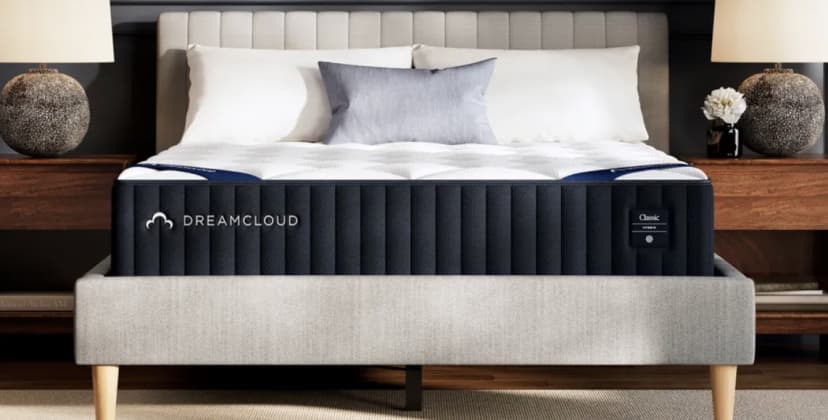
I’ve found the DreamCloud Classic Hybrid to be one of the best values out there — it delivers the kind of pressure relief, support, and temperature control you’d expect from much pricier mattresses, but with an approachable sticker price.
-
Pros
-
Multiple layers of gel-infused foam relieve pressure without excess heat buildup
-
Competitive price-point and 365-night sleep trial
-
FSA- and HSA-eligible
-
-
Cons
-
May lack adequate support for heavier stomach sleepers
-
Above-average off-gassing due to thick foam layers
-
Mattress Type
Hybrid
Firmness Options
Medium Firm (6)
Price Range
$419 – $1,198
Trial Period
365 nights (30-night requirement)
The DreamCloud Classic Hybrid costs far less than the average luxury hybrid yet still manages to perform at the same level as many competing models in terms of pressure relief, temperature control, and overall support. Many of our sleep testers weighing more than 230 pounds were impressed with the deep contouring and lack of sinkage, as mattresses with thick foam layers tend to feel less stable.
How It Performed
Our team’s strongest ratings for the DreamCloud Classic Hybrid came from side sleepers. The thick comfort system delivered much-needed cushioning for sensitive areas like the shoulders and hips. Meanwhile, the robust coil system kept most of our back and stomach sleepers on a mostly even plane.
Hybrids we’ve tested generally perform well for temperature control due to their gel-infused comfort layers and consistent internal airflow. The DreamCloud Classic Hybrid raises the bar with a breathable stretch-fabric cover and cooling gel infusion in the top layer.
The thick foam layers also earned the mattress above-average ratings for pressure relief and motion isolation compared to other hybrid models.
Construction Breakdown
Memory foam quilted into the DreamCloud’s cover gives the surface an invitingly plush feel. Transitional polyfoam reinforces this gentle cushioning, but these layers are progressively denser to help your body settle without sinking too much. Pocketed coils and high-density base foam provide a sturdy support system for the mattress.
The stretch-blend cover resists overheating and feels luxuriously soft. We’ve rated the DreamCloud Classic Hybrid as medium firm (6), but expect more contouring from this mattress than you’d normally find on a model with this firmness level. We attribute this to the thick 12-inch profile ensuring plenty of space for a deep comfort system and robust coil support.
The WinkBed Plus really shines for people over 230 pounds who need extra reinforcement from their mattress. The firmer feel delivers the kind of solid support that helps keep your body properly aligned, without sacrificing comfort. It’s built specifically to handle higher weight ranges, so you get durability and stability where it counts most.
-
Pros
-
Zoned latex and coil system provides enhanced support for shoulders, hips and back
-
Firm feel supports the body and prevents sagging
-
Sleeps cool, due to breathable latex and coil support core
-
-
Cons
-
Latex may not feel comfortable for people seeking a close contour
-
More expensive than standard WinkBed models
-
Mattress Type
Latex Hybrid
Firmness Options
Firm (8)
Price Range
$1,349 – $2,199
Trial Period
120 nights (30 night requirement)
The WinkBed is a luxury hybrid available in four firmness levels. The firmest option is the WinkBed Plus (8), one of the only mattresses on the market designed with heavier individuals in mind. Our testers found the mattress’ zoned comfort and support layers provide enhanced reinforcement from head to toe and noticed significant pushback around the torso and hips — two areas where people tend to carry a disproportionate amount of weight.
How It Performed
As expected, the WinkBed Plus earned strong ratings from our testers weighing more than 230 pounds across all three position groups. Gentle cushioning from the latex comfort layer combined with three-zone coil support helped ensure plenty of pushback and reinforcement for these team members.
We also gave the WinkBed Plus high marks for temperature control, as these tests revealed minimal heat buildup on the surface. Edge support tests were another highlight. The extra perimeter reinforcement allowed us to sit and lie along the edges of the mattress without feelings of “roll-off,” which we liken to being ejected by the mattress as it buckles beneath your weight.
Construction Breakdown
The WinkBed Plus differs in construction from the other three WinkBed models. A Euro-top cushioned with adaptive foam creates some light cushioning on the surface, but the zoned latex comfort layer responds quickly to compression and keeps you on an even plane.
The latex feels firmer and more supportive beneath your chest, stomach, and hips. In the support core, the coils are arranged similarly with thicker springs beneath your midsection for extra pushback. A cover made of breathable, moisture-wicking Tencel encases the mattress.
The Firmer WinkBed (7) also fared well among our heavier testers, earning “excellent” ratings from side, back, and stomach sleepers weighing more than 230 pounds.
What I like about the Leesa Plus Hybrid is that it offers more cushioning and contouring than a lot of other mattresses built for heavier sleepers without giving up the support you really need. It also does a great job staying cool, has sturdy edge support, and keeps motion transfer to a minimum, which is a big plus if you’re sharing the bed.
-
Pros
-
Adaptive foam layers provide light cushioning without too much of a body hug
-
Thick pocketed coils create a robust support system
-
Cover is composed of breathable, moisture-wicking poly-viscose fabric
-
-
Cons
-
Foam layers may emit harsh off-gassing smells for the first few nights
-
May not be supportive enough for stomach sleepers over 230 pounds
-
Mattress Type
Hybrid
Firmness Options
Medium Firm (6)
Price Range
$919 – $1,949
Trial Period
100 nights (30 night requirement)
The Leesa Plus Hybrid breaks from the trend of strong support but minimal contouring with a design that delivers ample cushioning without sacrificing reinforcement and stability. These qualities should appeal to anyone weighing more than 230 pounds who wants a bit of padding from their sleep surface but also needs steady pushback to keep their body on an even plane.
How It Performed
During our tests, the Leesa Plus earned higher ratings across different body type and sleep position groups than many competing models created for heavier individuals. This can be attributed to the balanced medium firm (6) feel and generous cushioning layers.
Temperature control is one of the Plus Hybrid’s defining strengths. Cooling gel infused into the top foam layer, a moisture-wicking cover, and steady airflow through the coils all contribute to the bed’s excellent thermoregulation.
Other testing highlights included edge support and ease of movement, and most of our testers who weigh more than 230 pounds reported little to no pressure buildup when lying on the mattress.
Construction Breakdown
The Plus Hybrid’s comfort system consists of three polyfoam layers, each one progressively denser to keep the surface comfortable and prevent you from sinking excessively. Responsive transitional foam also produces a light bounce when compressed, and this can help you move across the surface without feeling stuck.
Pocketed coils and dense base foam stabilize the mattress nicely. The perimeter coils are reinforced to push back against weight, allowing you and your partner to comfortably use the entire surface for sleep or sex. A cooling cover made from a blend of polyester and viscose encases the mattress.
I’ve found that the Nolah Evolution Comfort+ strikes a great balance between cushioning and support. Its deep foam layers and zoned coils feel especially sturdy where I need it most, offering solid reinforcement around the lower back and hips without feeling too firm at the head or legs.
-
Pros
-
Deep foam layers create a surface that’s both adaptive and supportive
-
Zoned coils push back against extra weight around the midsection
-
Breathable organic cotton cover is woven with heat-dissipating ArcticTex fibers
-
-
Cons
-
Potentially too firm for sleepers who prefer close contouring from their mattress
-
All returns incur a $99 processing fee
-
Mattress Type
Hybrid
Firmness Options
Firm (7)
Price Range
$974 – $2,079
Trial Period
120 nights (30-night requirement), $99 return pickup fee
Thanks to deep foam layers in the comfort system and coils engineered to feel more robust where people carry most of their weight, the firm (7) Nolah Evolution Comfort+ balances the cushioning and support side sleepers need.
How It Performed
Our testers noticed a plush feel on the Evolution Comfort+ when first lying on the mattress, followed by gentle pushback as their bodies settled. This adaptive, sink-free cradling comes from the progressively denser foam layers.
Temperature control was a major testing highlight. An open-cell composition allows each foam layer to resist heat buildup, the coils circulate plenty of air throughout the interior, and the cover is composed of breathable organic cotton woven with cooling ArcticTex fibers.
Our tests also show that the Evolution Comfort+ performs well in areas where hybrids often fall short, such as motion isolation for couples and pressure relief, but the mattress also feels stable around the perimeter and doesn’t sink too much when you move across its surface.
Construction Breakdown
The Evolution Comfort+ begins with a Euro-top containing four polyfoam layers. The two topmost layers are thicker and fairly adaptive, while the underlying two layers are dense and fairly firm.
This helps ensure even cushioning for your body without too much compression around the midsection. Zoned coils in the support core also help keep your body on an even plane. Thicker coils line the perimeter to stabilize the edges, as well.
The cover is made from a blend of organic cotton and proprietary ArcticTex fibers, the latter of which is a phase change material engineered to dissipate heat on contact.
The Evolution Comfort+ measures 14 inches thick and is considered a high-profile mattress, making it compatible with most fitted sheets — but we recommend measuring your sheet’s pocket depth to determine whether you’ll need new bedding for this mattress.
Best for Hot Sleepers
Brooklyn Bedding Aurora Luxe
Save 25% sitewide with code: MEMORIAL25
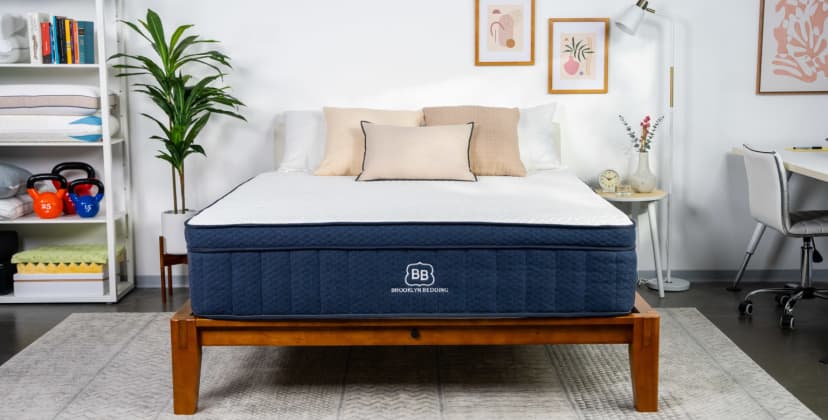
I’ve found that the Brooklyn Bedding Aurora Luxe stays comfortably cool, thanks to its thoughtful cooling features. Between the plush Euro-top, zoned coils, and a choice of firmness levels, it’s a well-rounded option that can work for a wide range of sleepers.
-
Pros
-
Offers an even mix of contouring and responsiveness
-
Sleeps cool, making it a good match for for hot sleepers
-
Three firmness options — soft, medium, firm
-
-
Cons
-
Strong off-gassing odor for the first few nights
-
Customers must pay $99 fee for mattress returns
-
Mattress Type
Hybrid
Firmness Options
Medium Soft (4), Medium Firm (6), Firm (7)
Price Range
$839 – $2,051
Trial Period
120 nights (30-night requirement)
If you weigh more than 230 pounds and sleep hot, the Brooklyn Bedding Aurora Luxe should check both boxes. Foam layers infused with copper and phase change material, coils that promote ample airflow throughout the interior, and a breathable cover all contribute to the Aurora Luxe’s superior temperature control.
How It Performed
You can choose from three firmness levels — our tests show the firm (8) is a good match for most people over 230 pounds, but the medium soft (4) and medium firm (6) provide a deeper contour if that aligns with your needs and preferences.
Most members of our testing team who weigh more than 230 pounds preferred the firm model. While the foams offer some cushioning, the surface doesn’t sink and remains flat and even. There’s also some extra bounce from the coils to ensure sufficient pushback beneath the torso and hips.
The medium firm model also might be suitable for people in this weight range who prefer a slightly closer contour from their mattress. All testers over 230 pounds agreed support was too lacking with the medium soft model.
Temperature control is a major strength of the Aurora Luxe, especially compared to other foam hybrids on the market. We noticed minimal heat buildup in the foam layers, along with cooling bursts that helped the surface stay comfortable.
The medium soft model excels at motion isolation and pressure relief — two performance areas where hybrids often struggle — while the medium firm and firm models earned higher ratings in testing categories like edge support and ease of movement.
Construction Breakdown
The Aurora Luxe’s comfort system contains three layers, beginning with 1.5 inches of adaptive polyfoam infused with copper fibers and phase change material.
Underlying polyfoam and transitional memory foam layers add to the plush, comfy feel of the Euro-top surface. For an extra fee, you can opt for the “Cooling Pillow Top” upgrade to your mattress. This add-on consists of a fourth foam layer encased in heat-dissipating fabric.
The support core’s pocketed coils are divided into three zones with extra strength beneath your midsection. Thicker coils also line the perimeter to prevent sinkage when you get in and out of bed. High-density base foam completes the hybrid design, and the standard-issue cover is made of polyester woven with phase change material for added cooling.
As someone who’s tested a lot of mattresses, I think the Bear Elite Hybrid stands out for heavier sleepers who struggle with hip pain. Its mix of memory foam and zoned polyfoam offers just the right balance of cushioning and support — enough to ease pressure around the hips while still keeping your back properly aligned.
-
Pros
-
Deep, adaptive foam layers contour evenly to alleviate pressure without too much hugging or sinkage
-
Pocketed coils promote airflow and reinforce the perimeter
-
Celliant cover can assist with physical recovery during sleep
-
-
Cons
-
Limited firmness options for those seeking a soft to medium soft mattress
-
Coils may generate too much movement for couples
-
Mattress Type
Hybrid
Firmness Options
Medium (5), Medium Firm (6), Firm (8)
Price Range
$1,231 – $2,548
Trial Period
120 nights (30-night break-in period)
Bear is an online mattress and bedding brand known for incorporating Celliant fabric in its products, which is designed to regulate temperature. The Bear Elite Hybrid stands out for its balanced construction and sturdy feel. Regardless of their primary sleep position, people of all body types should receive enough cushioning along the spine to alleviate pressure without sinking too much.
How It Performed
The mattress is available in three firmness options that correspond to medium (5), medium firm (6), and firm (8) on our firmness scale. All models have a pocketed coil system that offers robust support. The coils provide sturdy pushback along the perimeter, so anyone who sleeps near the edges of their mattress or struggles getting in and out of bed should feel secure.
Back and side sleepers preferred the medium and medium firm models, while stomach sleepers gravitated toward the firm model for its stronger support.
Construction Breakdown
The Bear Elite Hybrid begins with a layer of copper-infused memory foam under a Euro-top, followed by a polyfoam transitional layer. Celliant and phase change material in the cover are engineered to convert body heat into infrared energy, then transmit this energy back into your body through your skin.
This process is intended to regulate temperature and help with physical recovery during the night, making the Bear Elite Hybrid especially suitable for athletes, generally active individuals, and people with physically demanding jobs.
In our Test Lab, this mattress got great reviews from people over 230 pounds, regardless of their sleep position. The zoned latex and dense memory foam provide light contouring without too much sink, and the sturdy innerspring coils give it a super solid feel that also makes it easy to move around on.
-
Pros
-
Zoned latex and dense memory foam give the surface a sturdy, responsive feel
-
Thick hourglass coils encased in foam provide excellent support
-
All orders include a 365-night trial and free White Glove delivery
-
-
Cons
-
Above-average pricing for an innerspring
-
Limited motion isolation for co-sleepers
-
Mattress Type
Innerspring
Firmness Options
Firm (7)
Price Range
$1,795 – $3,990
Trial Period
365 Nights ($99 Return Fee)
The Saatva HD is one of the few luxury mattresses sold today that was specifically created for people who weigh more than 230 pounds. High-quality materials and excellent craftsmanship elevate the HD over traditional innersprings, but sleepers can still enjoy the sturdy support and signature bounce that have come to define this type of mattress.
How It Performed
As confirmed by our testers, the HD performs well among its target audience. Side sleepers weighing more than 230 pounds enjoyed the moderate cushioning of the top foam layer, which prevented pressure buildup in the shoulders and hips without contouring too closely.
Our back and stomach sleepers in the same weight range experienced little to no sinkage thanks to the zoned latex and thick, low-gauge offset coils.
We noticed minimal compression during our edge support tests, and all of us were able to scoot across the mattress with relative ease. Temperature control was another testing highlight. The ventilated latex and coil system promote plenty of airflow, so the HD consistently maintains a comfortable temperature, while the breathable cover helps the surface stay cool.
Construction Breakdown
The Saatva HD begins with Talalay latex encased in a luxurious Euro-top. This layer is divided into five firmness zones, pushing back against the extra weight in your midsection without feeling overly firm beneath your head and legs.
The next layer consists of gel-infused memory foam. This layer conforms somewhat to the body, but a dense composition prevents the close “hug” many people notice on softer foam mattresses. Transitional polyfoam serves as a buffer between your body and the support core.
Foam-encased offset coils deliver excellent reinforcement and stability to the entire mattress. The coils have a gauge of 12.5, making them very thick compared to those found in other innersprings, so you should expect significant bounce from this mattress. High-density base foam completes the support system, and an organic cotton cover encases the mattress.
The Titan Plus is built specifically with heavier sleepers in mind, and according to our testing team members over 230 pounds, it really delivers on that promise. It keeps a flat, even surface with very little contouring, which helps prevent that “stuck” feeling. I also appreciate how easy it is to move around on — plus, it stays pretty cool throughout the night.
-
Pros
-
Proprietary TitanFlex foam has latex-like responsiveness
-
Solid temperature regulation due to high-airflow coil design
-
Optional cooling top panel with phase change material
-
-
Cons
-
May not provide enough cushioning for side sleepers
-
Responsive design can produce movement and disrupt sleep for couples
-
Mattress Type
Hybrid
Firmness Options
Firm (8)
Price Range
$599 – $1,386
Trial Period
120 nights (30-night requirement)
Many mattresses sold today are suitable for people weighing more than 230 pounds, but the Titan Plus by Brooklyn Bedding is specifically designed for this sleeper demographic. A firm (8) model, our tests showed the Plus contours very little and maintains a flat, even sleep surface even for heavier individuals.
How It Performed
Our testers were divided about the Titan Plus, but it was a big hit among those weighing more than 230 pounds. The mattress received stellar ratings from all of our testers in this weight range across the side, back, stomach, and combination sleeping groups.
As an exceptionally firm mattress, the Plus performed well in some areas where softer hybrids tend to struggle. We noticed little to no sinkage while testing the mattress for edge support by lying along the perimeter and mimicking the movements of getting in and out of bed.
Ease of movement was another strong point, as none of our testers felt “stuck” moving across the surface. During the temperature control tests, our thermal sensors detected minimal heat buildup — we attribute this to the cooling cotton-knit cover and steady airflow through the coils.
Construction Breakdown
The Plus’ comfort system consists of two layers. Adaptive, gel-infused memory foam is sewn into the bottom of the cover to give the surface some gentle cushioning. The second layer is responsive, latex-like TitanFlex polyfoam that supports the spine and produces a light bounce when you get into bed. The support core contains pocketed coils over high-density base foam. Altogether, the Plus measures 11 inches thick.
A cotton-knit cover encases the mattress. While this breathable material helps promote air circulation, some may still notice heat retention in the foam layers. These sleepers are good candidates for the GlacioTex cover, which contains a phase change panel engineered to dissipate heat on contact and maintain a cool-to-the-touch feel. Adding the GlacioTex will increase the sticker price by $100 to $200, depending on your chosen size.
Video: We Tested the Best Mattress for Heavy People – Here Are Our Favorites
Watch our video below to learn more about our lab’s top mattress picks for heavy people.
What to Consider When Shopping for a Mattress for Heavy People
Like anyone, heavy people need a mattress that provides dependable comfort and support. Your mattress should feel sturdy enough to hold your spine in a neutral position and, at the same time, have enough cushioning to feel comfortable and inviting.
It’s easy to assume that the heavier you are, the softer and thicker the layers of your mattress should be. But I’ve learned that’s not exactly true. While thicker layers can be more supportive, mattresses that are too plush can make you feel like you’re sinking into quicksand.
That’s why I’m always in search of balance. The mattresses that our testing team have rated the highest have thoughtful designs, quality materials, and strong all-around performance.
That said, we’re all unique. My perfect mattress might feel terrible to you (and vice versa). That’s why I want to take the time to go over the main things to think about when you’re shopping for a mattress, so you can determine what’s best for your sleep.
Your Sleep Position
Your sleep position determines how your weight is distributed. If you’re a side sleeper (like me), your hips and shoulders may dig into the mattress. Or if you’re on your back or stomach, you may feel tension around your lumbar spine if you don’t get proper support.

So what does that mean in terms of choosing a mattress? It starts with getting the firmness level dialed in. Your mattress should provide the right amount of cushioning for your pressure points, but it also needs to resist sinking and sagging.
If you aren’t sure what firmness level you need, our testing team put together firmness recommendations for heavy people based on sleeping position, using data from thousands of hours of mattress testing. Keep in mind, these recommendations may not work for everyone, since comfort is inherently subjective.
| Sleeping Position | Recommended Firmness Level |
|---|---|
| Side | Medium Firm (6) to Firm (7 or 8) |
| Back | Firm (7 or 8) to Extra Firm (9) |
| Stomach | Firm (8) to Extra Firm (9) |
How Much of a ‘Hug’ You Want
Before I joined the testing team, I assumed the most comfortable mattress would be plush and closely contour around my body. From experience, though, I discovered that, while I love a good bear hug from my wife or best friend, I didn’t want one from my mattress.
Some contouring can help cushion your pressure points so you don’t wake up stiff and sore. But too much hug can jeopardize support. It can also feel hot and stuffy — as a hot sleeper, that’s a dealbreaker for me.
Although personal preferences vary, our testing team has found that a gentler and more moderate amount of hug is best for the majority of people who weigh 230 pounds or more. I suggest looking for a mattress along those lines unless you know from past experience that you prefer something different.
Responsiveness and Edge Support
Do you remember what it was like to play in a ball pit as a kid? It was fun to sink down and then climb your way out. But I’m not a kid anymore, and I don’t want my mattress to feel like a ball pit. In fact, I get downright annoyed when I feel like I have to climb out of my mattress.
That’s the idea of “responsiveness” in a mattress. A highly responsive mattress is the opposite of the ball pit: There’s a bit of pushback when you want to move. The mattress materials spring back quickly, retaking their shape when you move or get out of bed.
For heavier people, having a more responsive mattress can be a major plus. It not only keeps you from being stuck in place but also creates more reliable perimeter support (think: sitting on the edge of your bed).
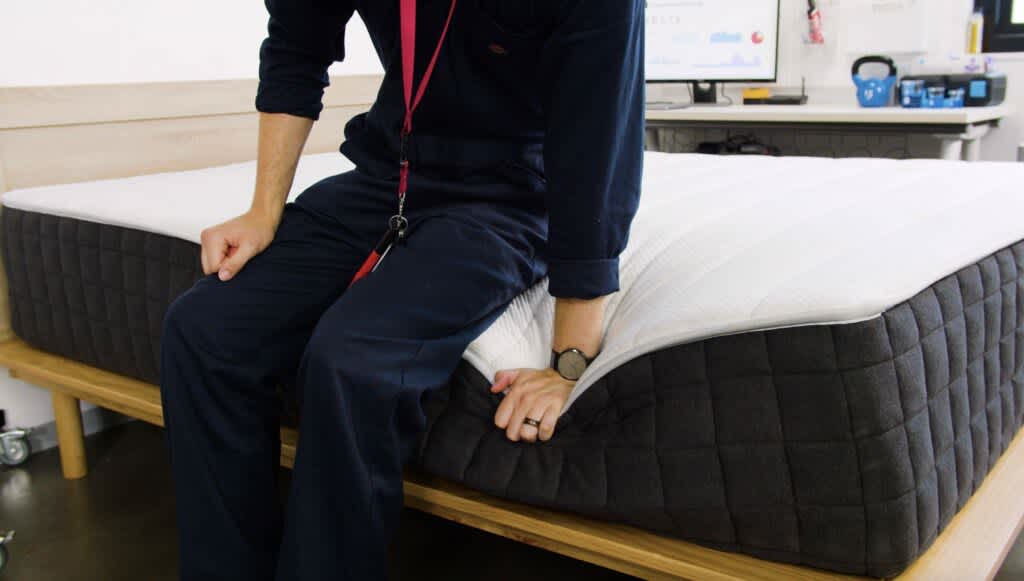
Durability
We all depend on our mattresses night after night, so consistent performance and durability really matter. Through testing hundreds of beds over the years, I’ve seen firsthand how certain mattresses hold up better than others, especially when they’re built to support larger bodies.
The truth is, every mattress will wear out eventually, no matter who’s sleeping on it. But if you’re putting extra pressure on your bed, choosing a sturdier, well-constructed model can add years to its lifespan. And while these mattresses might come with a higher price tag upfront, they often pay off by holding their shape and support much longer than flimsier options.
Sleeping With a Partner
Finding the right mattress to share with a partner isn’t just about body weight — it also comes down to your individual sleep positions, firmness preferences, and comfort needs. Sometimes you’ll get lucky and find a middle ground that works well for both of you. Other times, compromise might not cut it.
If your preferences are too different, one solution is to look for a mattress with dual firmness options, where each side of the bed offers a different feel. These setups can be pricier and limit your choices, but they’re a great way to make sure everyone sleeps comfortably.
At the end of the day, picking a mattress as a couple is all about making sure both people get the rest they need. Whether that means finding a shared solution, opting for split firmness, or adding a topper to one side, the goal is the same: better sleep for both of you.
Sleep Temperature
Some people seem to always run hot, including at night. With the wrong mattress, that can mean constant sleep disruptions, waking up sweating bullets and kicking off blankets. If you sleep hot like me, look for a mattress with materials that resist heat buildup.
From my experience and our in-house testing, that usually means a latex mattress or one with metal coils or springs. As for mattress covers, several types of materials, such as cotton, Tencel, and viscose derived from bamboo, offer breathability that can help combat sleeping hot.
You can also choose a mattress with cooling features, like gel or copper infusions or phase change materials, designed to dissipate extra heat so that it doesn’t build up around your body while you sleep.

What Mattress Types Are Best for Heavy People?
Mattress shopping has always been a bit overwhelming, but it can feel even tougher today with the growing number of brands and models. If you’re on the heavy side, options are more plentiful than they once were, but it may be helpful to start by focusing on a few mattress types that are more likely to meet your needs.
Hybrid
Hybrids are built with a base of bouncy innerspring coils and top layers of pressure-relieving materials like foam and latex. I’ve found that most hybrids strike a good balance of cushioning and sturdiness. That lets me sleep comfortably without worrying about excess sinkage.
When shopping for hybrids, though, it’s important to look closely at how they’re built. Some are too soft or conforming for heavy sleepers.
Latex
Latex is a robust and durable material that lightly embraces the body but doesn’t have a deep hug. It’s bouncy and doesn’t trap heat like some other materials. With these characteristics, latex mattresses regularly get high ratings during our tests from people over 230 pounds.
Airbed
Airbeds let you adjust the firmness of your mattress with the touch of a button. For heavy people, this offers the utmost flexibility in finding a comfortable and supportive feel. Plus, most airbeds are designed so that you can set different firmness levels on each side, making them great for couples who don’t share the same comfort preferences.
What Mattress Types Are Less Than Ideal for Heavy People?
Certain types of mattress construction tend to pose problems for heavier people. If you see one of these models, it’s not a full-on dealbreaker, but it’s best to proceed with caution.
Memory Foam
Memory foam hugs the body, which can feel overly soft and stuffy to some heavier people. Significant sinkage can reduce back support and spinal alignment. Plus, memory foam mattresses can also trap heat and feel especially weak around the edge.
Innerspring
Traditional innersprings feel firm, but that’s because they have almost no cushioning for your joints and pressure points. They also have some of the worst durability ratings, and their already short lifespan may be even shorter for heavier people.
Low-Profile Mattresses
Although this rule isn’t set in stone, I typically advise people over 230 pounds to avoid mattresses that are under 8 inches tall. With such a low profile, these mattresses often have layers that are too thin to provide reliable cushioning, support, and comfort.
Sleep Tips for Heavy People
Over the years of testing mattresses and diving deep into the world of sleep health, I’ve picked up a few tips that might be helpful for you, too.
First: I’m a big fan of adjustable bed frames. Being able to raise either the head or foot of the bed makes a surprising difference in comfort — especially if you deal with snoring, breathing issues, or just like reading in bed. As our sleep expert Dr. Adavadkar points out, elevating the head can help reduce snoring and ease certain breathing difficulties, making adjustable beds a smart option for many people.
Second: Don’t underestimate the power of good pillows. Life is too short for flat, unsupportive pillows. The right pillow can do wonders for your neck and spinal alignment. I also recommend having an extra pillow (or a body pillow) on hand to support your lower back or knees if needed.
And finally: If you’re struggling with persistent sleep issues — like regular daytime drowsiness, loud snoring, or difficulty staying asleep — don’t chalk it up to stress or try to power through it with caffeine. Talk to your doctor. Sometimes these symptoms point to a sleep disorder like sleep apnea, and getting the right diagnosis can be life-changing.
What I’m Sleeping On
My wife and I sleep on the Brooklyn Bedding Bloom. We’ve been very happy with this latex-hybrid model, but sadly, the company no longer sells it. So we’re shopping for a new mattress and leaning toward another one from Brooklyn Bedding (possibly even the Aurora Luxe, which we ranked well for hot sleepers above).
Not only have we appreciated the Bloom’s performance over the last 7 years (it’s lasted through four different cats and a 150-pound dog!), but most of Brooklyn’s current mattresses are available in different firmness levels — including options for someone like me who needs extra support.
How We Test: Your Comfort Is Our Science
Our industry-leading product testing team takes sleep seriously. We strongly believe that better sleep can be transformative, and we see it as our responsibility to help guide you to mattresses and other sleep products that can help you get better rest.
In our Seattle-based Test Lab, we use a hands-on method to evaluate mattresses. We’ve been using and refining this process for nearly a decade, testing nearly 2,000 mattresses in the process. Our mattress breakdowns are based on a few different steps.
Construction analysis: We start by taking a close look at details of how each mattress is made, including the materials and height of each layer and the overall mattress firmness.
Product testing: Direct testing is crucial to our ratings. We take advantage of technological tools to measure things like heat buildup, motion transfer, and pressure relief. Feedback from our testers who weigh more than 230 pounds was key to narrowing down our top picks for this list.
Field testing: Each mattress goes home with a member of our testing team. Their feedback gives us a more well-rounded perspective on how a mattress performs night after night.
User testing: We curate feedback that verified owners have provided in surveys and product reviews. This provides context for the rest of our findings, allowing us to tweak our ratings if necessary to reflect real-world experiences.
How We Determine Our Overall Scores

To determine a mattress’s overall score, we assign weighted percentages to different performance categories. We give more weight to the categories with a bigger impact on sleep satisfaction.
Performance Categories
Motion Isolation
Motion isolation describes how well a mattress prevents you from feeling vibrations when there is movement on another part of the mattress. Hands-on testing with a vibrometer allows us to see how well a mattress isolates motion.
Temperature Control
To determine how well a mattress regulates temperature, we use heat mapping technology and look closely at the materials in each layer of the mattress design.
Pressure Relief
Specific pressure mapping equipment lets us see how much pressure builds up around the joints and other pain points when a person is lying on a mattress. We evaluate pressure relief for people of different body weights and in different sleeping positions.
Ease of Movement
This reflects how easily a sleeper can move across a bed’s surface, which is important for people with mobility issues. Responsive or bouncy surfaces (such as latex) typically perform better than foam surfaces, which can inhibit movement.
Edge Support
To rate edge support, we perform tests along a bed’s perimeter to measure how well the edges push back against weight when sitting and lying down. Mattresses with strong edge support have minimal sagging close to the perimeter.
Off-Gassing
A mattress that is compressed and shipped in a box may release unpleasant chemical odors for a short period after you’ve unboxed it. Our team works to gauge both the intensity and duration of any off-gassing odors.
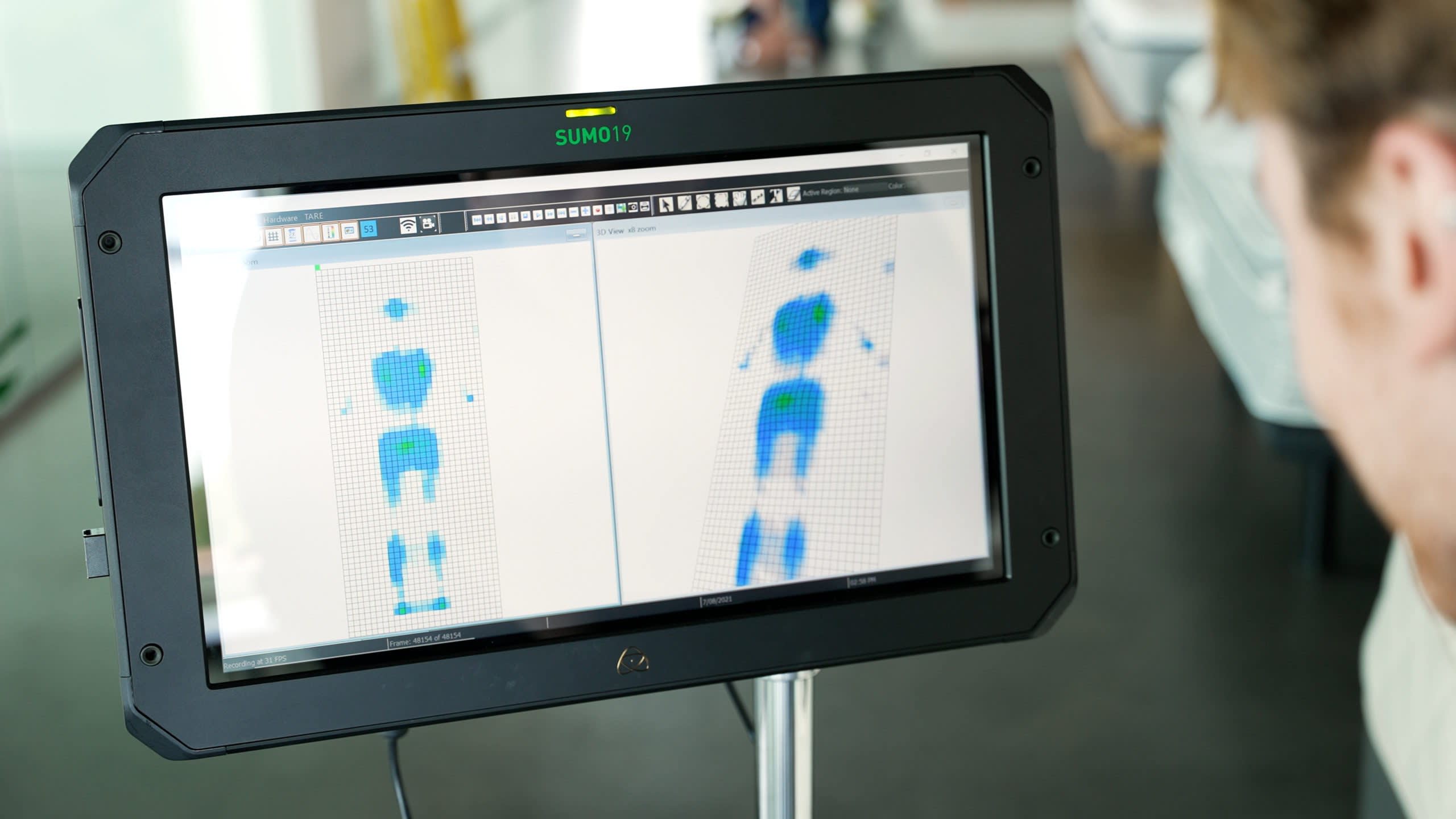
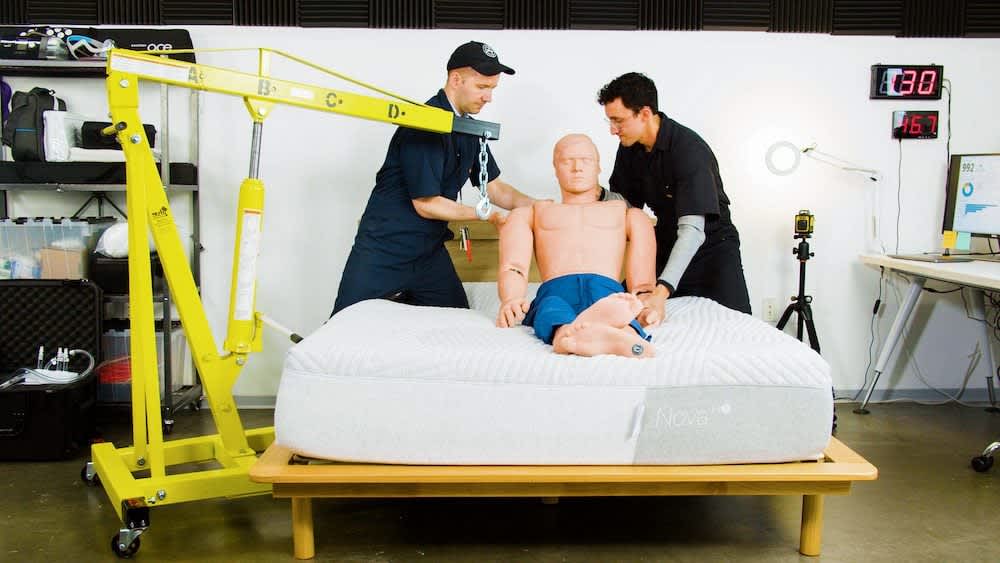

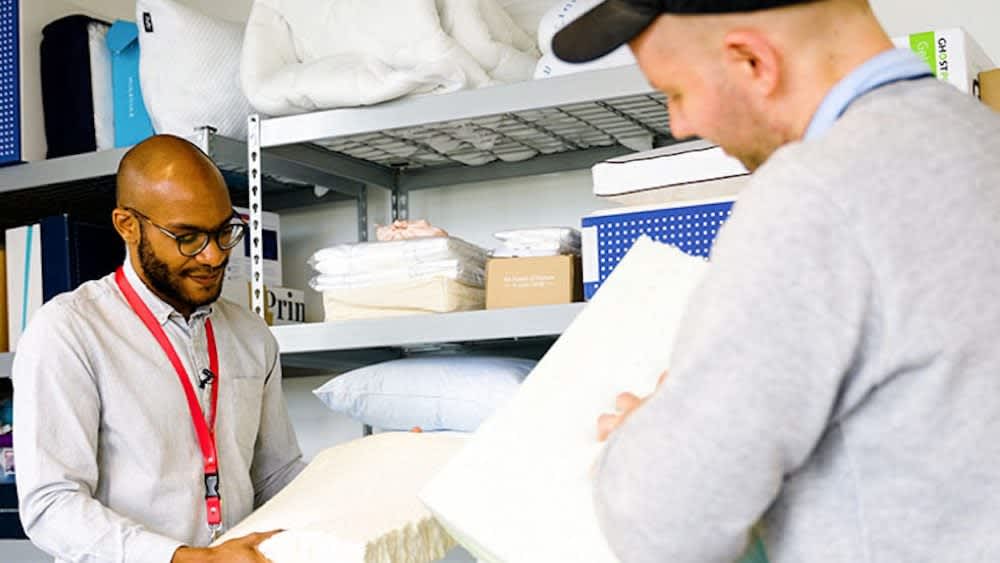
More Mattress Guides
Still haven’t found your perfect mattress? For more help deciding which mattress is right for your specific needs, check out the guides below.
Best Mattress by Sleeper Type
Frequently Asked Questions
Do mattresses have a weight limit?
It varies, but most mattresses have a weight capacity between 500 and 700 pounds for a queen or king size. Other models are built to have higher weight capacities for heavier sleepers. I’ve found that some manufacturers list this information on their websites, but for many mattress companies, you have to email them or use their online chat service to get a specific number.
What is a bariatric mattress and who is it best for?
A bariatric mattress is specifically designed for heavier people with medical needs. These mattresses tend to be firmer, with a more robust and heavy-duty build. Most bariatric mattresses support between 600 and 1,000 pounds.
Some medical equipment distributors require a prescription for bariatric mattresses, while select retailers sell them without a prescription. If your doctor prescribes a bariatric mattress, insurance may cover some or all of the cost.
Do heavier people need to replace their mattress more often?
It depends on the quality of the mattress, but in general, yes, mattresses can wear out faster under higher weight. More body weight means more pressure on the materials, which can lead to sagging or loss of support sooner than the typical 7- to 10-year lifespan often advertised by manufacturers.
I recommend choosing a well-built mattress with high-density foams, sturdy coils, or reinforced support zones to help extend its durability. Keep an eye out for signs like sagging, lumps, or waking up sore — these are clues that your mattress may no longer be doing its job.

Still have questions? Ask our community!
Join our Sleep Care Community — a trusted hub of product specialists, sleep health professionals, and people just like you. Whether you’re searching for the perfect mattress or need expert sleep advice, we’ve got you covered. Get personalized guidance from the experts who know sleep best.


